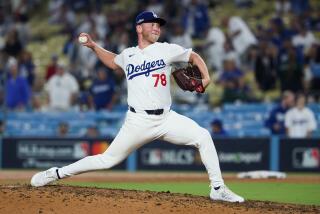Theories on Why Hitters Had Nightmares in 1968
- Share via
There is no concrete reason, astrological explanation nor mathematical hypothesis why 1968 should have been such a dominating season for pitchers. There are, however, a few educated guesses:
--Pitching coaches. “Collectively, the game was going in a new direction,” said Denny McLain, who won 31 games for the Detroit Tigers. “The professionals had real major league pitching coaches, rather than just the managers’ buddies. Johnny Sain (with the Tigers) was around at that time, and so was Sid Hudson (with the Washington Senators). These guys knew pitching and how to get the job done.”
--The strike zone. Willie Mays said umpires were making it bigger.
--The stadiums. “You got at least two parks in our league that ought to be outlawed,” Curt Flood of the St. Louis Cardinals told Time magazine that year. “In San Francisco, the wind blows 90 m.p.h. in your face. In Los Angeles, the park is so big, you’ve got to play golf--hit the ball, go get it and hit it again.”
Yet, the wind still blows at Candlestick Park, and the fences didn’t come in at Dodger Stadium until 1973, and then only 5 feet at the most, and there has yet to be a repeat of ’68.
Will there ever be?
“I don’t think so, because you don’t have that style of pitcher anymore,” said Don Drysdale, the star of the Dodgers’ staff 20 years ago. “The other reason is the programming of today’s baseball is not on starting and complete games. You’re talking basically starters--(Juan) Marichal, McLain, (Bob) Gibson, Drysdale, (Sandy) Koufax (who retired in 1966). Today, it’s, ‘If you give me five or six innings, we’ll take care of it after that.’ There’s a completely different mentality in the game today.”
But, he added, anything is possible, even someone breaking his record of 58 scoreless innings.
“I think it’s approachable,” Drysdale said. “If you’ve got anything on the ball and if they expand again, why, hell, someone may do 88 innings. The talent’s diluted. . . . There are 240 more players in the major leagues today than when I played. If you went back to two eight-team leagues, you’d have some great play. But they’re talking about expanding again now, so through expansion it’s approachable. Anything can happen through expansion.
“I believe hitting and pitching goes in cycles. I will say that from 1969, everything they’ve done since (was) to legislate, really, against pitching. I think it’s a well-kept secret. No one will admit to it, but baseball, the hierarchy, would rather see runs scored than they would a good 1-0 or 2-1 pitching duel.
“They’ll deny it, but they’re denying it because of the public-relations factor. They can’t come out publicly and say, ‘We are trying to legislate against pitching, we want more offense.’ If they said that, it would almost be to the point of where they would lose all credibility. But it’s being done that way, it’s quite obvious.”
The most immediate legislation in 1968 was to lower the mound the next season from 15 inches to 10. But, Gibson pointed out, that really only hurt pitchers who threw with a straight overhand motion.
Theories, all. The only facts are the numbers, and those are the best barometer of what took place 20 years ago: The earned-run average in the National League has risen from 2.99 in 1968 to 3.58 in 1978 to 4.08 in 1987; in the American League from 2.98 to 3.77 to 4.46. During the same 20-year span, batting averages have increased from .230 to .265 in the American and from .243 to .261 in the National.
More to Read
Are you a true-blue fan?
Get our Dodgers Dugout newsletter for insights, news and much more.
You may occasionally receive promotional content from the Los Angeles Times.










